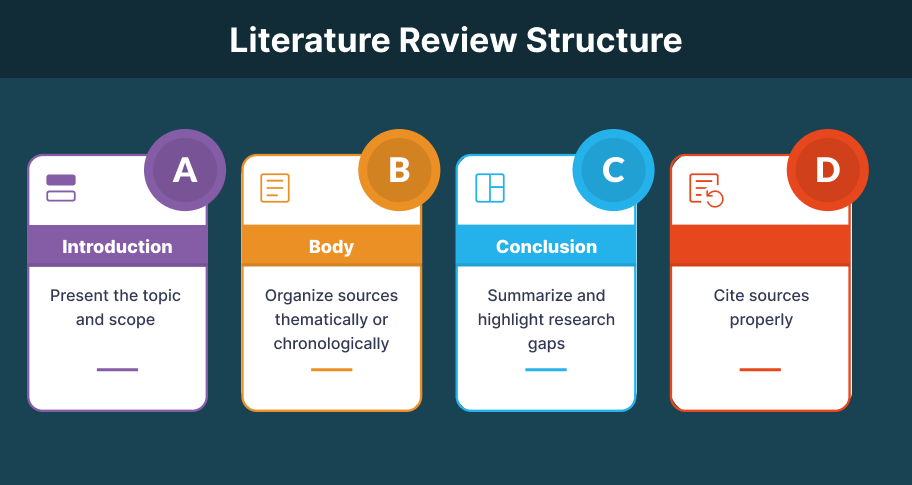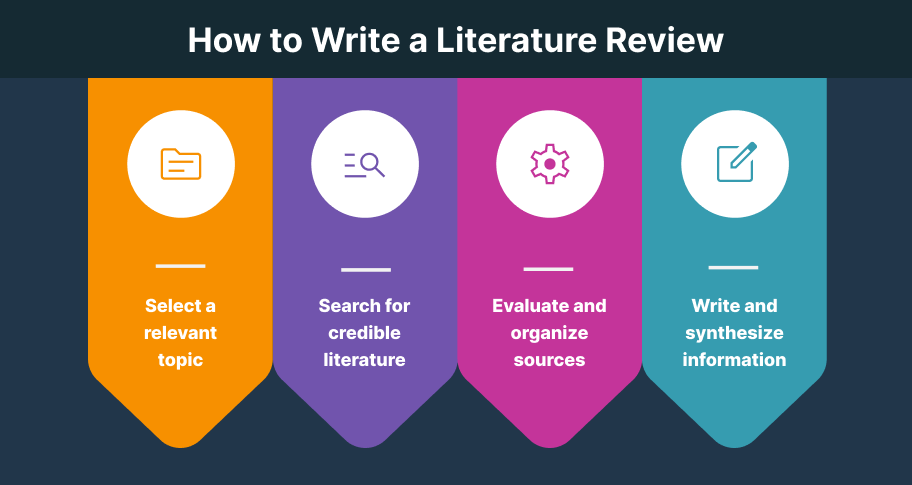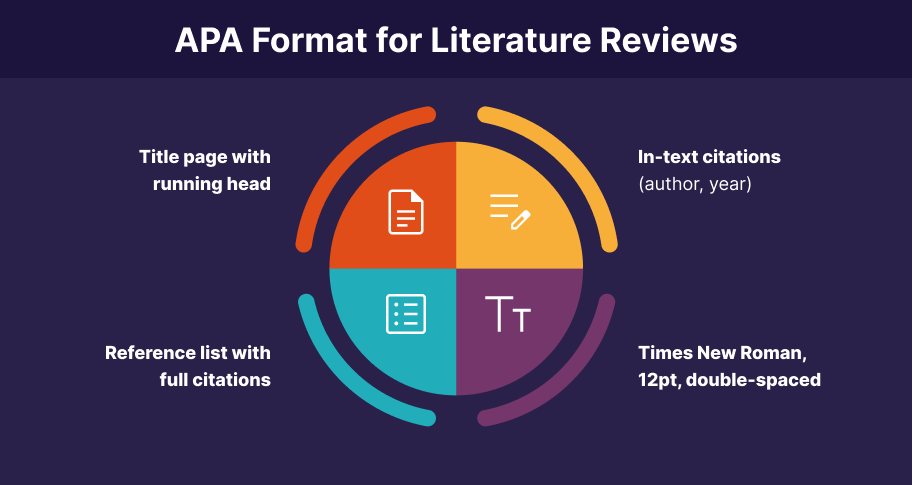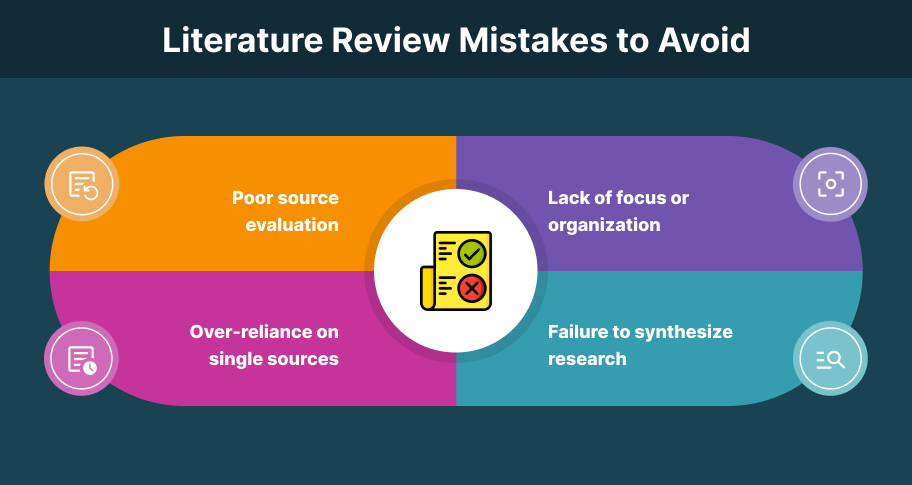- Study Documents
- Learning Tools

Writing Guides
- Citation Generator
- Flash Card Generator
- Homework Help
- Essay Examples
- Essay Title Generator
- Essay Topic Generator
- Essay Outline Generator
- Flashcard Generator
- Plagiarism Checker
- Paraphrasing Tool
- Conclusion Generator
- Thesis Statement Generator
- Introduction Generator
- Literature Review Generator
- Hypothesis Generator
- Human Editing Service
- Essay Hook Generator
Writing Guides / How to Write a Literature Review with Examples
How to Write a Literature Review with Examples

Introduction
Writing a literature review is a necessary and important step in academic research. You’ll likely write a lit review for your Master’s Thesis and most definitely for your Doctoral Dissertation. It’s something that lets you show your knowledge of the topic. It’s also a way to show off yourself as an expert in the area. The literature review establishes the fact that you’ve done your due diligence.
For your reader, it is a good way to communicate just what is out there in terms of existing knowledge about your research topic. The lit review allows you to summarize and assess the current state of research, by bringing together and synthesizing available studies on the matter.
Ultimately, the literature review lets you present a summary of the body of knowledge and use that to identify research gaps that you can then try to fill. It is incredibly helpful in setting up a theoretical framework and justification for your own study.
This guide will help you understand what is a literature review so that you’ll know its value and importance, as well as how to write one effectively.
What is a Literature Review?
A literature review is a synthesis and critical analysis of research relevant to a specific topic or research question that you have raised for study. It is more than a summary of sources; it is a critical evaluation that weaves together current and past literature to reveal patterns, theoretical insights, research directions, and research gaps.
The main point of a literature review is to show a well-rounded understanding of the state of the topic with regard to existing studies. It helps researchers position their work in the context of what is already known, how it fits, why it is necessary, or how it extends the current understanding.
It also serves to build a solid foundation for further research, by acting as a backdrop against which new research contributions can be made.
Importance of a Literature Review in Academic Research
A literature review is necessary as it will serve several purposes for your research:
- Understanding the Field : First, the literature review provides an overview of the existing body of knowledge, which helps researchers understand the scope of previous studies and what has already been uncovered in the field.
- Identifying Gaps : Second, when they look at existing literature, researchers can more easily identify where research is lacking or where questions remain unanswered. These gaps form the justification for new investigations.
- Critical Analysis : Third, a literature review allows the researcher to critically analyze how previous studies have been conducted, what methodologies were used, what evidence was uncovered, whether they sufficiently addressed the research problem, or what areas of research are still needed.
- Theoretical Framework : Fourth, the literature review acts as support for the development of a theoretical framework with which the research can be conducted and interpreted, as it grounds the study in ideas based existing data.
Types of Literature Reviews
There are different types of literature reviews for different purposes. Knowing when to use each type will help you shape your own review.
Narrative Review
A narrative review gives an overview of the topic by focusing on the development of theories and concepts over time. It is often descriptive and used when only a brief review is possible. Its weakness is that it lacks the systematic methodology of more structured reviews. However, narrative reviews are useful for obtaining a quick understanding of the topic and where research has focused in the past.
Systematic Review
A systematic review is more rigorous than a narrative review. It has a very methodical approach to searching for and reviewing existing literature. This type of review is characterized by its well-defined research question and a detailed, reproducible methodology that allows for the collection, critical appraisal, and synthesis of all relevant evidence. Inclusion and exclusion criteria are stated. Due to their structured and transparent nature, systematic reviews are particularly prevalent in fields like healthcare and social sciences, where evidence-based conclusions are needed for guiding practice and policy decisions.
The methodology of a systematic review begins with the precise formulation of a research question, which serves as the foundation for the entire review process.
Next, a fully detailed search strategy is developed so that all relevant studies are identified. The researcher will usually require access to multiple databases and literature types (white and grey papers, etc.). The inclusion and exclusion criteria must be explicitly defined to show which studies will be considered and which will be excluded, based on predetermined factors like study design, population, year published, language, and relevance to the research question.
Finally, the data extraction and analysis phase involves systematically gathering data from the selected studies and conducting a detailed analysis, which may include quantitative synthesis (like meta-analysis) or a qualitative assessment of the evidence. This approach allows the researcher to make sure the findings are robust, reliable, and can be replicated in future research.
Theoretical Review
A theoretical review looks at theories relevant to a particular area of study. It focuses on conceptual frameworks that have been developed to explain phenomena, analyze theories’ strengths and limitations, and propose new theoretical approaches if necessary. These reviews are helpful when the research is going to explore or challenge existing theoretical assumptions.
Integrative Review
An integrative review synthesizes existing research to generate new perspectives or frameworks. Unlike systematic reviews, integrative reviews will use both qualitative and quantitative studies and offer a broader analysis of the literature. This type is helpful for researchers who want to develop new and deeper insights and more holistic theories by integrating a wider array of research findings.

Steps to Writing a Literature Review
Writing a literature review can seem like a lot to take on. However, it is a very manageable process when you break it down into simple steps. Here’s our step-by-step guide on how to write a literature review.
Step 1: Select a Topic
The first step in writing a literature review is to choose a topic that is relevant and interesting to your research field. It should align with your research objectives. It should be specific and focused. Don’t make it too broad—but also don’t make it so narrow that you can’t find any research on it at all. You want there to be ample literature available to review. Your research will build on that.
Tip : Focus on a specific research question that your literature review will address. Try using field relevant keywords when you search ideas in literature databases.
Step 2: Search for Relevant Literature
Once your topic is chosen, conduct a thorough search for academic sources. Use databases like PubMed, JSTOR, or Google Scholar to find peer-reviewed articles, books, and conference papers.
- Use keywords related to your topic.
- Apply filters like publication date and research area.
- Search in libraries, academic journals, and trusted repositories.
Step 3: Evaluate and Analyze the Sources
Not all sources are created equal. Critically evaluate the quality and relevance of the literature. Consider the credibility of the author, the validity of the research methods, and the significance of the findings.
Criteria for Evaluation
- Author’s credentials and publication source
- Research design and methodology
- The study’s contribution to the field
Step 4: Organize the Literature
Organize your sources based on common themes, methodologies, findings, or the chronological development of ideas. A well-structured literature review outline can help. For example, you may categorize studies based on:
- Theoretical concepts
- Methodological approaches
- Historical progression
Organization Tips
- Use thematic or chronological order to maintain a coherent review.
- Identify major trends and seminal works in the field.
Step 5: Write the Literature Review
When writing, strive for a balanced discussion. Do not just summarize; synthesize and analyze. Critique the sources. Discuss the findings in a way that brings information in from multiple studies. Point out agreements, contradictions, and unanswered questions among the various sources.
Writing Tips
- Start each section with a strong topic sentence.
- Use clear and concise language.
- Maintain an objective tone, and do not inject personal opinions.
Literature Review Format
- Introduction: Present your research question and explain the purpose of the review.
- Body: Discuss studies in a structured manner.
- Conclusion: Summarize key findings and suggest future research directions.

Structure of a Literature Review
A literature review typically follows a standard structure.
Introduce your topic and explain the review’s purpose. Clearly define the scope and outline the organization of the review.
The body is where you organize your sources. This can be done thematically (grouping similar studies together) or chronologically (presenting research in order of publication). Integrate studies by discussing their contributions and limitations.
Important Reminders
- Use transition words to maintain a logical flow.
- Highlight influential works and major shifts in the research.
Summarize the insights gained from your review. Highlight research gaps and suggest directions for future study. This section also emphasizes the significance of your research within the broader academic context.
Literature Review Example
The Impact of Social Media on Adolescent Mental Health
Here is our literature review example to show you how yours can look.
Social media usage among adolescents has sparked concern among mental health professionals (Uhls et al., 2017). Given that young people today are among the most active social media users, it is important to know how these platforms impact their psychological well-being. Adolescents are at a developmental stage where identity and role confusion represent the major conflict of their age according to Erikson’s psychosocial model. Social media platforms provide a space for this dramatic conflict to play out in ways that researchers are still trying to understand (Best et al., 2014).
Numerous studies have explored the relationship between social media engagement and various mental health outcomes (Maktelow & Taylor, 2014; Przybylski et al., 2013; Uhls et al., 2017). However, the findings are often mixed, and show both beneficial and harmful effects. This literature review focuses on the positive aspects of social media, such as peer support, the negative outcomes like heightened anxiety and depression, and the limitations inherent in the methodologies used by these studies.
Positive Impacts of Social Media: Peer Support and Connection
Research on the positive implications of social media for adolescent mental health indicates that these platforms have a lot to do with how social connections are established and the extent to which peer support is obtained (Best et al., 2014). Social media can promote a sense of belonging and provide adolescents with emotional support from their peers (Best et al., 2014). These online interactions can be beneficial for adolescents who experience social isolation or struggle with face-to-face interactions (Uhls et al., 2017). The ability to connect with peers who share similar experiences or interests can give a level of emotional affirmation that traditional offline interactions sometimes lack.
Uhls et al. (2017) described the importance of online communities in providing adolescents with opportunities for social engagement and self-expression, suggesting that these platforms allow teens to seek advice, share personal experiences, and receive encouragement, which can contribute positively to their self-esteem. Adolescents experiencing challenges such as bullying or family issues often turn to social media communities for support and validation, where they feel understood and less alone. In this way, the social connectivity afforded by platforms like Facebook, Instagram, and Snapchat can enhance adolescents’ overall well-being and promote resilience.

Negative Consequences of Social Media: Anxiety, Depression, and Self-Esteem Issues
Even though social media can offer emotional benefits, extensive evidence also points to its potential to harm adolescent mental health. One of the most frequently documented adverse outcomes is increased anxiety and depression linked to excessive social media use (Twenge & Campbell, 2018). Twenge and Campbell (2018) conducted a large-scale study that revealed a correlation between high levels of social media engagement and rising rates of depressive symptoms among teenagers. The researchers argued that the constant exposure to curated and often idealized representations of others’ lives led to feelings of inadequacy, poor self-image, and heightened anxiety. Adolescents may feel pressured to project a perfect image of themselves online, which can be exhausting and detrimental to their self-esteem.
Moreover, the concept of “fear of missing out” (FOMO) has emerged as a significant factor contributing to adolescent anxiety. FOMO refers to the pervasive apprehension that others are having rewarding experiences from which one is absent (Przybylski et al., 2013). Adolescents who experience FOMO are more likely to engage in compulsive social media checking, which disrupts their daily routines, sleep patterns, and academic performance (Przybylski et al., 2013). This behavior creates a cycle of anxiety and stress, as constant comparison and the need to remain connected exacerbate feelings of inadequacy.
Another area of concern is the impact of cyberbullying, which has become increasingly common with the advent of social media. Patchin and Hinduja (2015) found that victims of online harassment are more likely to experience severe psychological distress, like suicidal ideation and self-harm. Unlike traditional bullying, cyberbullying can occur at any time and is often anonymous, making it particularly relentless and damaging. The permanence of online interactions means that harmful content can be shared and viewed repeatedly, amplifying the psychological toll on victims. As a result, the mental health repercussions of cyberbullying can be profound and long-lasting.
Methodological Limitations in Existing Research
Despite the wealth of research on the relationship between social media and adolescent mental health, several methodological limitations complicate the interpretation of findings. One significant challenge is the reliance on self-reported data, which can be subject to bias. Adolescents may not accurately recall or may choose to underreport the extent of their social media use or the severity of their psychological symptoms (Keles et al., 2020). Reliance on self-reported measures makes it difficult to establish causal relationships between social media use and mental health outcomes.
Furthermore, many studies use cross-sectional designs, which cannot determine the directionality of the relationship between social media use and mental health (Patchin & Hinduja, 2015). It remains unclear whether increased social media use leads to poorer mental health or if adolescents struggling with mental health issues are more likely to seek out social media as a coping mechanism. Longitudinal research is needed to better understand the temporal dynamics of this relationship. The heterogeneity of social media platforms also complicates research, as different platforms may have unique features that affect users differently.. For example, visual platforms like Instagram may have a different psychological impact than text-based platforms like Twitter, and few if any studies have accounted for these nuances.
Another limitation involves the cultural context of social media use. Much of the research is conducted in Western countries, primarily the United States and Europe, which may not fully capture the full experience of adolescent social media engagement. Cultural differences in social norms, values, and access to technology can influence how adolescents use social media and how it affects their well-being. Thus, a culturally diverse research approach may be necessary to draw the most applicable conclusions.
The impact of social media on adolescent mental health has positive and negative dimensions. Social media platforms offer adolescents opportunities to seek peer support and partake of social engagement. At the same time there is the risk of excessive use and negative experiences, such as cyberbullying and FOMO, which are linked to increased anxiety, depression, and self-esteem issues. Existing research reveals methodological limitations such as self-reported data, cross-sectional designs, and a lack of cultural diversity in studies. Future research should focus on longitudinal studies and culturally sensitive approaches for a fuller understanding of how social media influences adolescent mental health. Moreover, intervention strategies that teach adolescents healthy social media habits and provide resources for coping with online stressors may be needed.
Best, P., Manktelow, R., & Taylor, B. (2014). Online communication, social media and adolescent wellbeing: A systematic narrative review. Children and Youth Services Review , 41, 27-36.
Keles, B., McCrae, N., & Grealish, A. (2020). A systematic review: The influence of social media on depression, anxiety, and psychological distress in adolescents. International Journal of Adolescence and Youth , 25(1), 79-93.
Patchin, J. W., & Hinduja, S. (2015). Measuring cyberbullying: Implications for research. Aggression and Violent Behavior , 23, 69-74.
Przybylski, A. K., Murayama, K., DeHaan, C. R., & Gladwell, V. (2013). Motivational, emotional, and behavioral correlates of fear of missing out. Computers in Human Behavior , 29(4), 1841-1848.
Twenge, J. M., & Campbell, W. K. (2018). Associations between screen time and lower psychological well-being among children and adolescents: Evidence from a population-based study. Preventive Medicine Reports , 12, 271-283.
Uhls, Y. T., Ellison, N. B., & Subrahmanyam, K. (2017). Benefits and costs of social media in adolescence. Pediatrics , 140(Supplement 2), S67-S70.
APA Literature Review Format
When writing in APA style, an APA literature review must follow specific guidelines for citation and formatting.
APA Formatting Guidelines
- Title Page : Include the title, author’s name, and institutional affiliation.
- Abstract : A brief summary of your review (usually 150-250 words).
- In-text Citations : Use the author-date citation method (e.g., Smith, 2020).
- Reference List : Provide full citations for all referenced works in alphabetical order.
Tips : Always adhere to the latest APA manual for formatting rules.

Literature Review Templates
A literature review template can simplify the process of organizing your review. You can find templates for APA, MLA, or Harvard formats at Purdue OWL . These templates provide a ready-to-use framework, so that your review is well-structured.
Common Mistakes to Avoid When Writing a Literature Review
Even experienced researchers can fall into common pitfalls. Here’s what to avoid:
- Lack of Focus : Make sure your review addresses a clear research question.
- Poor Organization : Avoid a scattered presentation. Use an outline to maintain structure.
- Failure to Synthesize : Do not just list sources. Instead, integrate and compare studies to show meaningful conclusions.
- Outdated Sources : Always use recent and relevant research unless discussing foundational theories.

Literature Review FAQ
How long should a literature review be?
The length depends on the purpose and scope of your study. A literature review for a dissertation is typically longer than one for a research paper.
Can I include non-academic sources in a literature review?
Generally, it’s best to prioritize peer-reviewed and scholarly sources. However, in some cases, reputable non-academic sources may be used to provide additional context.
How do I structure a literature review for a dissertation?
Follow a detailed outline that includes an introduction, a well-organized body (thematic or chronological), and a concise conclusion. Discuss theories, methodologies, and identify research gaps.
Writing a literature review may seem like a tremendous challenge, but don’t give up! Use our tips and idea, maintain focus, and take it step by step. You’ll find that with a structured approach, even an inexperienced researcher can quickly gain a feel for how to write a literature review! Remember, a well-organized review can help you identify gaps that your own research can fill. Don’t skip on your lit review—dive in and use it to make your research thesis or dissertation even better.
Still need assistance with your literature review? View or download our free literature review worksheet to help get you started.
Take the first step to becoming a better academic writer.
Writing tools.
- How to write a research proposal 2021 guide
- Guide to citing in MLA
- Guide to citing in APA format
- Chicago style citation guide
- Harvard referencing and citing guide
- How to complete an informative essay outline

How to Choose the Best Essay Topics

AI Text Detection Services


Unlock Your Writing Potential with Our AI Essay Writing Assistant

The Negative Impacts of Artificial Intelligence on Tactile Learning

What is a Literature Review? How to Write It (with Examples)

A literature review is a critical analysis and synthesis of existing research on a particular topic. It provides an overview of the current state of knowledge, identifies gaps, and highlights key findings in the literature. 1 The purpose of a literature review is to situate your own research within the context of existing scholarship, demonstrating your understanding of the topic and showing how your work contributes to the ongoing conversation in the field. Learning how to write a literature review is a critical tool for successful research. Your ability to summarize and synthesize prior research pertaining to a certain topic demonstrates your grasp on the topic of study, and assists in the learning process.
Table of Contents
What is the purpose of literature review , a. habitat loss and species extinction: , b. range shifts and phenological changes: , c. ocean acidification and coral reefs: , d. adaptive strategies and conservation efforts: .
- Choose a Topic and Define the Research Question:
- Decide on the Scope of Your Review:
- Select Databases for Searches:
- Conduct Searches and Keep Track:
- Review the Literature:
- Organize and Write Your Literature Review:
- How to write a literature review faster with Paperpal?
Frequently asked questions
What is a literature review .
A well-conducted literature review demonstrates the researcher’s familiarity with the existing literature, establishes the context for their own research, and contributes to scholarly conversations on the topic. One of the purposes of a literature review is also to help researchers avoid duplicating previous work and ensure that their research is informed by and builds upon the existing body of knowledge.

A literature review serves several important purposes within academic and research contexts. Here are some key objectives and functions of a literature review: 2
1. Contextualizing the Research Problem: The literature review provides a background and context for the research problem under investigation. It helps to situate the study within the existing body of knowledge.
2. Identifying Gaps in Knowledge: By identifying gaps, contradictions, or areas requiring further research, the researcher can shape the research question and justify the significance of the study. This is crucial for ensuring that the new research contributes something novel to the field.
Find academic papers related to your research topic faster. Try Research on Paperpal
3. Understanding Theoretical and Conceptual Frameworks: Literature reviews help researchers gain an understanding of the theoretical and conceptual frameworks used in previous studies. This aids in the development of a theoretical framework for the current research.
4. Providing Methodological Insights: Another purpose of literature reviews is that it allows researchers to learn about the methodologies employed in previous studies. This can help in choosing appropriate research methods for the current study and avoiding pitfalls that others may have encountered.
5. Establishing Credibility: A well-conducted literature review demonstrates the researcher’s familiarity with existing scholarship, establishing their credibility and expertise in the field. It also helps in building a solid foundation for the new research.
6. Informing Hypotheses or Research Questions: The literature review guides the formulation of hypotheses or research questions by highlighting relevant findings and areas of uncertainty in existing literature.
Literature review example
Let’s delve deeper with a literature review example: Let’s say your literature review is about the impact of climate change on biodiversity. You might format your literature review into sections such as the effects of climate change on habitat loss and species extinction, phenological changes, and marine biodiversity. Each section would then summarize and analyze relevant studies in those areas, highlighting key findings and identifying gaps in the research. The review would conclude by emphasizing the need for further research on specific aspects of the relationship between climate change and biodiversity. The following literature review template provides a glimpse into the recommended literature review structure and content, demonstrating how research findings are organized around specific themes within a broader topic.
Literature Review on Climate Change Impacts on Biodiversity:
Climate change is a global phenomenon with far-reaching consequences, including significant impacts on biodiversity. This literature review synthesizes key findings from various studies:
Climate change-induced alterations in temperature and precipitation patterns contribute to habitat loss, affecting numerous species (Thomas et al., 2004). The review discusses how these changes increase the risk of extinction, particularly for species with specific habitat requirements.
Observations of range shifts and changes in the timing of biological events (phenology) are documented in response to changing climatic conditions (Parmesan & Yohe, 2003). These shifts affect ecosystems and may lead to mismatches between species and their resources.
The review explores the impact of climate change on marine biodiversity, emphasizing ocean acidification’s threat to coral reefs (Hoegh-Guldberg et al., 2007). Changes in pH levels negatively affect coral calcification, disrupting the delicate balance of marine ecosystems.
Recognizing the urgency of the situation, the literature review discusses various adaptive strategies adopted by species and conservation efforts aimed at mitigating the impacts of climate change on biodiversity (Hannah et al., 2007). It emphasizes the importance of interdisciplinary approaches for effective conservation planning.
Strengthen your literature review with factual insights. Try Research on Paperpal for free!
How to write a good literature review
Writing a literature review involves summarizing and synthesizing existing research on a particular topic. A good literature review format should include the following elements.
Introduction: The introduction sets the stage for your literature review, providing context and introducing the main focus of your review.
- Opening Statement: Begin with a general statement about the broader topic and its significance in the field.
- Scope and Purpose: Clearly define the scope of your literature review. Explain the specific research question or objective you aim to address.
- Organizational Framework: Briefly outline the structure of your literature review, indicating how you will categorize and discuss the existing research.
- Significance of the Study: Highlight why your literature review is important and how it contributes to the understanding of the chosen topic.
- Thesis Statement: Conclude the introduction with a concise thesis statement that outlines the main argument or perspective you will develop in the body of the literature review.
Body: The body of the literature review is where you provide a comprehensive analysis of existing literature, grouping studies based on themes, methodologies, or other relevant criteria.
- Organize by Theme or Concept: Group studies that share common themes, concepts, or methodologies. Discuss each theme or concept in detail, summarizing key findings and identifying gaps or areas of disagreement.
- Critical Analysis: Evaluate the strengths and weaknesses of each study. Discuss the methodologies used, the quality of evidence, and the overall contribution of each work to the understanding of the topic.
- Synthesis of Findings: Synthesize the information from different studies to highlight trends, patterns, or areas of consensus in the literature.
- Identification of Gaps: Discuss any gaps or limitations in the existing research and explain how your review contributes to filling these gaps.
- Transition between Sections: Provide smooth transitions between different themes or concepts to maintain the flow of your literature review.
Write and Cite as yo u go with Paperpal Research. Start now for free!
Conclusion: The conclusion of your literature review should summarize the main findings, highlight the contributions of the review, and suggest avenues for future research.
- Summary of Key Findings: Recap the main findings from the literature and restate how they contribute to your research question or objective.
- Contributions to the Field: Discuss the overall contribution of your literature review to the existing knowledge in the field.
- Implications and Applications: Explore the practical implications of the findings and suggest how they might impact future research or practice.
- Recommendations for Future Research: Identify areas that require further investigation and propose potential directions for future research in the field.
- Final Thoughts: Conclude with a final reflection on the importance of your literature review and its relevance to the broader academic community.

Conducting a literature review
Conducting a literature review is an essential step in research that involves reviewing and analyzing existing literature on a specific topic. It’s important to know how to do a literature review effectively, so here are the steps to follow: 1
Choose a Topic and Define the Research Question:
- Select a topic that is relevant to your field of study.
- Clearly define your research question or objective. Determine what specific aspect of the topic do you want to explore?
Decide on the Scope of Your Review:
- Determine the timeframe for your literature review. Are you focusing on recent developments, or do you want a historical overview?
- Consider the geographical scope. Is your review global, or are you focusing on a specific region?
- Define the inclusion and exclusion criteria. What types of sources will you include? Are there specific types of studies or publications you will exclude?
Select Databases for Searches:
- Identify relevant databases for your field. Examples include PubMed, IEEE Xplore, Scopus, Web of Science, and Google Scholar.
- Consider searching in library catalogs, institutional repositories, and specialized databases related to your topic.
Conduct Searches and Keep Track:
- Develop a systematic search strategy using keywords, Boolean operators (AND, OR, NOT), and other search techniques.
- Record and document your search strategy for transparency and replicability.
- Keep track of the articles, including publication details, abstracts, and links. Use citation management tools like EndNote, Zotero, or Mendeley to organize your references.
Review the Literature:
- Evaluate the relevance and quality of each source. Consider the methodology, sample size, and results of studies.
- Organize the literature by themes or key concepts. Identify patterns, trends, and gaps in the existing research.
- Summarize key findings and arguments from each source. Compare and contrast different perspectives.
- Identify areas where there is a consensus in the literature and where there are conflicting opinions.
- Provide critical analysis and synthesis of the literature. What are the strengths and weaknesses of existing research?
Organize and Write Your Literature Review:
- Literature review outline should be based on themes, chronological order, or methodological approaches.
- Write a clear and coherent narrative that synthesizes the information gathered.
- Use proper citations for each source and ensure consistency in your citation style (APA, MLA, Chicago, etc.).
- Conclude your literature review by summarizing key findings, identifying gaps, and suggesting areas for future research.
Whether you’re exploring a new research field or finding new angles to develop an existing topic, sifting through hundreds of papers can take more time than you have to spare. But what if you could find science-backed insights with verified citations in seconds? That’s the power of Paperpal’s new Research feature!
How to write a literature review faster with Paperpal?
Paperpal, an AI writing assistant, integrates powerful academic search capabilities within its writing platform. With the Research | Cite feature, you get 100% factual insights, with citations backed by 250M+ verified research articles, directly within your writing interface. It also allows you auto-cite references in 10,000+ styles and save relevant references in your Citation Library. By eliminating the need to switch tabs to find answers to all your research questions, Paperpal saves time and helps you stay focused on your writing.
Here’s how to use the Research feature:
- Ask a question: Get started with a new document on paperpal.com. Click on the “Research | Cite” feature and type your question in plain English. Paperpal will scour over 250 million research articles, including conference papers and preprints, to provide you with accurate insights and citations.

- Review and Save: Paperpal summarizes the information, while citing sources and listing relevant reads. You can quickly scan the results to identify relevant references and save these directly to your built-in citations library for later access.
- Cite with Confidence: Paperpal makes it easy to incorporate relevant citations and references in 10,000+ styles into your writing, ensuring your arguments are well-supported by credible sources. This translates to a polished, well-researched literature review.

The literature review sample and detailed advice on writing and conducting a review will help you produce a well-structured report. But remember that a good literature review is an ongoing process, and it may be necessary to revisit and update it as your research progresses. By combining effortless research with an easy citation process, Paperpal Research streamlines the literature review process and empowers you to write faster and with more confidence. Try Paperpal Research now and see for yourself.
A literature review is a critical and comprehensive analysis of existing literature (published and unpublished works) on a specific topic or research question and provides a synthesis of the current state of knowledge in a particular field. A well-conducted literature review is crucial for researchers to build upon existing knowledge, avoid duplication of efforts, and contribute to the advancement of their field. It also helps researchers situate their work within a broader context and facilitates the development of a sound theoretical and conceptual framework for their studies.
Literature review is a crucial component of research writing, providing a solid background for a research paper’s investigation. The aim is to keep professionals up to date by providing an understanding of ongoing developments within a specific field, including research methods, and experimental techniques used in that field, and present that knowledge in the form of a written report. Also, the depth and breadth of the literature review emphasizes the credibility of the scholar in his or her field.
Before writing a literature review, it’s essential to undertake several preparatory steps to ensure that your review is well-researched, organized, and focused. This includes choosing a topic of general interest to you and doing exploratory research on that topic, writing an annotated bibliography, and noting major points, especially those that relate to the position you have taken on the topic.
Literature reviews and academic research papers are essential components of scholarly work but serve different purposes within the academic realm. 3 A literature review aims to provide a foundation for understanding the current state of research on a particular topic, identify gaps or controversies, and lay the groundwork for future research. Therefore, it draws heavily from existing academic sources, including books, journal articles, and other scholarly publications. In contrast, an academic research paper aims to present new knowledge, contribute to the academic discourse, and advance the understanding of a specific research question. Therefore, it involves a mix of existing literature (in the introduction and literature review sections) and original data or findings obtained through research methods.
Literature reviews are essential components of academic and research papers, and various strategies can be employed to conduct them effectively. If you want to know how to write a literature review for a research paper, here are four common approaches that are often used by researchers. Chronological Review: This strategy involves organizing the literature based on the chronological order of publication. It helps to trace the development of a topic over time, showing how ideas, theories, and research have evolved. Thematic Review: Thematic reviews focus on identifying and analyzing themes or topics that cut across different studies. Instead of organizing the literature chronologically, it is grouped by key themes or concepts, allowing for a comprehensive exploration of various aspects of the topic. Methodological Review: This strategy involves organizing the literature based on the research methods employed in different studies. It helps to highlight the strengths and weaknesses of various methodologies and allows the reader to evaluate the reliability and validity of the research findings. Theoretical Review: A theoretical review examines the literature based on the theoretical frameworks used in different studies. This approach helps to identify the key theories that have been applied to the topic and assess their contributions to the understanding of the subject. It’s important to note that these strategies are not mutually exclusive, and a literature review may combine elements of more than one approach. The choice of strategy depends on the research question, the nature of the literature available, and the goals of the review. Additionally, other strategies, such as integrative reviews or systematic reviews, may be employed depending on the specific requirements of the research.
The literature review format can vary depending on the specific publication guidelines. However, there are some common elements and structures that are often followed. Here is a general guideline for the format of a literature review: Introduction: Provide an overview of the topic. Define the scope and purpose of the literature review. State the research question or objective. Body: Organize the literature by themes, concepts, or chronology. Critically analyze and evaluate each source. Discuss the strengths and weaknesses of the studies. Highlight any methodological limitations or biases. Identify patterns, connections, or contradictions in the existing research. Conclusion: Summarize the key points discussed in the literature review. Highlight the research gap. Address the research question or objective stated in the introduction. Highlight the contributions of the review and suggest directions for future research.
Both annotated bibliographies and literature reviews involve the examination of scholarly sources. While annotated bibliographies focus on individual sources with brief annotations, literature reviews provide a more in-depth, integrated, and comprehensive analysis of existing literature on a specific topic. The key differences are as follows:
References
- Denney, A. S., & Tewksbury, R. (2013). How to write a literature review. Journal of criminal justice education , 24 (2), 218-234.
- Pan, M. L. (2016). Preparing literature reviews: Qualitative and quantitative approaches . Taylor & Francis.
- Cantero, C. (2019). How to write a literature review. San José State University Writing Center .
Paperpal is a comprehensive AI writing toolkit that helps students and researchers achieve 2x the writing in half the time. It leverages 22+ years of STM experience and insights from millions of research articles to provide in-depth academic writing, language editing, and submission readiness support to help you write better, faster.
Get accurate academic translations, rewriting support, grammar checks, vocabulary suggestions, and generative AI assistance that delivers human precision at machine speed. Try for free or upgrade to Paperpal Prime starting at US$19 a month to access premium features, including consistency, plagiarism, and 30+ submission readiness checks to help you succeed.
Experience the future of academic writing – Sign up to Paperpal and start writing for free!
Related Reads:
- Empirical Research: A Comprehensive Guide for Academics
- How to Write a Scientific Paper in 10 Steps
- How Long Should a Chapter Be?
- How to Use Paperpal to Generate Emails & Cover Letters?
6 Tips for Post-Doc Researchers to Take Their Career to the Next Level
Self-plagiarism in research: what it is and how to avoid it, you may also like, what is the purpose of an abstract why..., research process steps: research procedure and examples, what are citation styles which citation style to..., what are the types of literature reviews , what are research skills definition, importance, and examples , what is phd dissertation defense and how to..., abstract vs introduction: what is the difference , mla format: guidelines, template and examples , machine translation vs human translation: which is reliable..., what is academic integrity, and why is it....
Harvey Cushing/John Hay Whitney Medical Library
- Collections
- Research Help
YSN Doctoral Programs: Steps in Conducting a Literature Review
- Biomedical Databases
- Global (Public Health) Databases
- Soc. Sci., History, and Law Databases
- Grey Literature
- Trials Registers
- Data and Statistics
- Public Policy
- Google Tips
- Recommended Books
- Steps in Conducting a Literature Review
What is a literature review?
A literature review is an integrated analysis -- not just a summary-- of scholarly writings and other relevant evidence related directly to your research question. That is, it represents a synthesis of the evidence that provides background information on your topic and shows a association between the evidence and your research question.
A literature review may be a stand alone work or the introduction to a larger research paper, depending on the assignment. Rely heavily on the guidelines your instructor has given you.
Why is it important?
A literature review is important because it:
- Explains the background of research on a topic.
- Demonstrates why a topic is significant to a subject area.
- Discovers relationships between research studies/ideas.
- Identifies major themes, concepts, and researchers on a topic.
- Identifies critical gaps and points of disagreement.
- Discusses further research questions that logically come out of the previous studies.
APA7 Style resources
APA Style Blog - for those harder to find answers
1. Choose a topic. Define your research question.
Your literature review should be guided by your central research question. The literature represents background and research developments related to a specific research question, interpreted and analyzed by you in a synthesized way.
- Make sure your research question is not too broad or too narrow. Is it manageable?
- Begin writing down terms that are related to your question. These will be useful for searches later.
- If you have the opportunity, discuss your topic with your professor and your class mates.
2. Decide on the scope of your review
How many studies do you need to look at? How comprehensive should it be? How many years should it cover?
- This may depend on your assignment. How many sources does the assignment require?
3. Select the databases you will use to conduct your searches.
Make a list of the databases you will search.
Where to find databases:
- use the tabs on this guide
- Find other databases in the Nursing Information Resources web page
- More on the Medical Library web page
- ... and more on the Yale University Library web page
4. Conduct your searches to find the evidence. Keep track of your searches.
- Use the key words in your question, as well as synonyms for those words, as terms in your search. Use the database tutorials for help.
- Save the searches in the databases. This saves time when you want to redo, or modify, the searches. It is also helpful to use as a guide is the searches are not finding any useful results.
- Review the abstracts of research studies carefully. This will save you time.
- Use the bibliographies and references of research studies you find to locate others.
- Check with your professor, or a subject expert in the field, if you are missing any key works in the field.
- Ask your librarian for help at any time.
- Use a citation manager, such as EndNote as the repository for your citations. See the EndNote tutorials for help.
Review the literature
Some questions to help you analyze the research:
- What was the research question of the study you are reviewing? What were the authors trying to discover?
- Was the research funded by a source that could influence the findings?
- What were the research methodologies? Analyze its literature review, the samples and variables used, the results, and the conclusions.
- Does the research seem to be complete? Could it have been conducted more soundly? What further questions does it raise?
- If there are conflicting studies, why do you think that is?
- How are the authors viewed in the field? Has this study been cited? If so, how has it been analyzed?
Tips:
- Review the abstracts carefully.
- Keep careful notes so that you may track your thought processes during the research process.
- Create a matrix of the studies for easy analysis, and synthesis, across all of the studies.
- << Previous: Recommended Books
- Last Updated: Jun 20, 2024 9:08 AM
- URL: https://guides.library.yale.edu/YSNDoctoral
